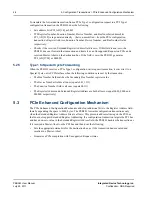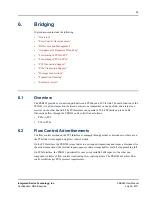
6. Bridging > Exclusive Access
57
PEB383 User Manual
July 25, 2011
Integrated Device Technology, Inc.
Confidential - NDA Required
6.11
Exclusive Access
ThePEB383 provides an exclusive access method, which allows non-exclusive accesses to proceed
while exclusive accesses take place. This allows a master to hold a hardware lock across several
accesses without interfering with non-exclusive data transfer. Locked transaction sequences are
generated by the host processor(s) as one or more reads followed by a number of writes to the same
location(s). The PEB383 supports locked transactions only in the downstream direction. Upstream
Lock transactions are handled with the LOCKn signal ignored.
A Lock is established when all the following conditions are met:
•
A PCIe device initiates a Memory Read Lock (MRdLk) request to read from a target PCI device
•
LOCKn is asserted on the PCI bus
•
The target PCI device responds with a TRDYn
The bus is unlocked when the Unlock Message TLP is received on the PCIe link.
ThePEB383 enters into target-lock state when it receives a MRdLk TLP, and enters into full-lock state
when it receives successful completion from the target device. ThePEB383 attempts locked read
request on the PCI bus only after all the requests received prior to the locked request are completed on
the bus. While in target-lock state, thePEB383 handles all the received TLPs with UR but continues to
accept the transactions on the PCI Interface.
When thePEB383 enters into full-lock state, all upstream transactions on the PCI Interface are retried
and all the downstream requests on the PCIe Interface, except Memory transactions, are handled as
UR. Requests pending in upstream queues or buffers and internally generated messages are not allowed
to be forwarded to the PCIe Interface until thePEB383 is unlocked from the PCIe Interface. However,
thePEB383 accepts read completions for upstream read requests that were issued before the lock was
established on the PCI bus when they return on the PCIe link.
As soon as the PCI bus is locked, any PCIe cycle to PCI is driven with the PCI_LOCKn
pin asserted,
even if that specific cycle is not locked. This is not expected to occur because under the lock, the
upstream component must not send any non-locked transactions downstream.
During the LOCK sequence, when the initial locked read command results in a master or target abort
on the PCI bus, thePEB383 does not establish lock, and it sends a completion packet on the PCIe link
with an error status. In case of a subsequent memory read or memory write receiving a target or master
abort during a LOCK sequence, thePEB383 unlocks only after the unlock message is received on the
PCIe Interface.






























